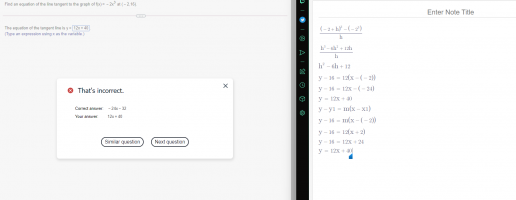Finding a tangent line
- Thread starter joshmeyer
- Start date
BigBeachBanana
Senior Member
- Joined
- Nov 19, 2021
- Messages
- 2,277
It seems like you're trying to use the definition of derivative to find f'(x). You forgot that you'd have to take the limit as h->0, and you didn't apply the definition correctly. Are you required to use the definition of limit? It can be easily done by the power rule.View attachment 31799
I have absolutely no idea what I've done wrong, and unlike my last post, it's not that I didn't read instructions.
Last edited:
I sadly have not been taught the power rule yet, but as it's an online course the only thing I have to show is the answer. If I could learn said power rule to skip what's 5 steps that would be greatIt seems like you're trying to use the definition of derivative to find f'(x). You forgot that you'd have to take the limit as h->0, and you didn't apply the definition correctly. Are you required to use the definition of limit? It can be easily done by the power rule.
It's time consuming to expand binomials past the power of 3
D
Deleted member 4993
Guest
But you need to expand the binomial to power 3 - not past power 3.It's time consuming to expand binomials past the power of 3
Use:
(a + b)3 = a3 + 3a2b + 3ab2 + b3
BigBeachBanana
Senior Member
- Joined
- Nov 19, 2021
- Messages
- 2,277
I'm a bit surprised that you haven't learned the power rule, which is one of the most basic rules of taking derivatives, yet you're doing tangent lines. Anyhow, since you haven't learned the power rule yet, we can stick with what you learnedI sadly have not been taught the power rule yet, but as it's an online course the only thing I have to show is the answer. If I could learn said power rule to skip what's 5 steps that would be great
It's time consuming to expand binomials past the power of 3
f′(x)=h→0limh−2(x+h)3−(−2x3)Use the binomial theorem Subhotosh Khan provided in post#4 to continue.

